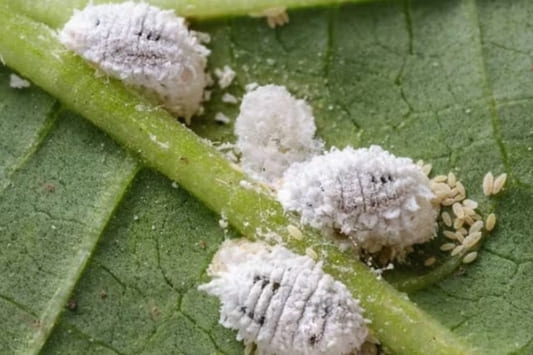How to eliminate the cottony mealybug: Complete guide to protect your plants from this dangerous pest

One day you check the undersides of your plant leaves, and there it is.
A small insect that looks like a cotton ball. But despite its endearing appearance, you know that its presence poses a serious risk to your plants.
We're talking about the citrus mealybug.
This pest is one of the most common in any garden.
But there's a silver lining because it means we know many effective remedies to combat it.
And in this post, we're going to explain them all to you.
But let's start from the beginning...
The first step to eliminate the citrus mealybug: learn to identify it
The citrus mealybug usually hides in the stems of plants and on the undersides of leaves (the "back" part).
That's why it's not always easy to spot it at first glance.
Many times, we realize it's there when we notice that the plant is sick because:
- The leaves turn yellow and wither.
- The fruits don't form properly.
- Even some branches may die.
In the worst cases, its presence can lead to more dangerous pests, such as fungi.
This insect feeds on plant sap.
If you notice any of these signs, thoroughly inspect your plants for these insects. They are easy to see because they look like small cotton balls attached to the plant.
Different methods to eliminate citrus mealybugs from your plants
1. Homemade methods
It's always advisable to start with natural methods. So, we have:
- Water and soap: the simplest method is to make a soapy water mixture and spray it on the affected plants. The soap breaks down the waxy protective layer of mealybugs, making them vulnerable to water.
- Isopropyl alcohol: moisten a cotton ball with isopropyl alcohol and gently rub the affected leaves. This method dehydrates and eliminates mealybugs, causing them to detach from the plants.
- Specific oils: you can use neem oil or black soap (olive oil-based), which work well as natural insecticides. But beware! Do not use them on oil-sensitive plants (flowering and delicate-leaved plants such as chrysanthemums, poinsettias, primroses, coleus, orchids, and cacti, for example).
This system works well if you have a few affected plants because you can treat them one by one.
But what if the infestation has already spread to several plants?
Or when the quantity of mealybugs is so huge that it's impossible to deal with them using these methods?
That's when we need to take more effective measures to eliminate this pest.
2. Plant protection products
There are different plant protection products useful for eliminating mealybugs. So, we have:
- Natural insecticides (suitable for organic farming).
- Systemic insecticides (that serve both to eliminate the pest and prevent its appearance).
- Specific anti-mealybug products.
Which one is more interesting?
The reality is that this question doesn't have an easy answer because many factors will influence it.
If you have doubts, it's best to contact your trusted nursery for advice.
Fighting pests is good, but preventing them is even better
1. Regularly examine your plants
Plants are like us: when they get sick (or in this case, when they suffer from a pest), acting as soon as possible increases the chances of recovery.
That's why it's interesting to regularly check the condition of your plants.
This way, you can act in time if you notice any strange symptoms or if you discover that mealybugs or other dangerous pests have started to settle in.
2. Make sure you know their specific care needs
Many times, mealybugs attack plants that are already weakened.
This can happen when you haven't provided them with the conditions of:
- Watering.
- Nutrients.
- Sun exposure.
- Temperature.
They need.
Keep in mind that not all plants are the same, and depending on their characteristics, they will need different care.
If, when introducing a new plant into your home, you thoroughly research how to care for it, the chances of it suffering from a pest or disease will be greatly reduced.
3. Attract natural enemies of mealybugs to your garden
Just as some insects are harmful to our plants, others can be beneficial.
For example, ladybugs are voracious eaters of aphids and mealybugs.
Their presence will help keep these pests in check and improve the health of your plants.
And the good news is that there are some tricks to attract them to your garden.
Are your plants suffering from an attack of citrus mealybugs? Let us help you
At Viveros González, we have been guiding our customers for many years to keep their plants healthy and happy.
And we can do the same for you.
Just enter here and tell us your specific situation so we can advise you.
See you very soon!

 English
English Spanish
Spanish